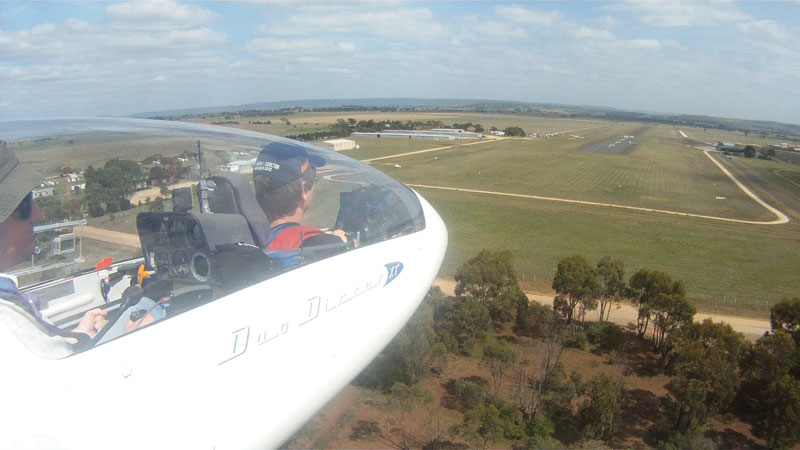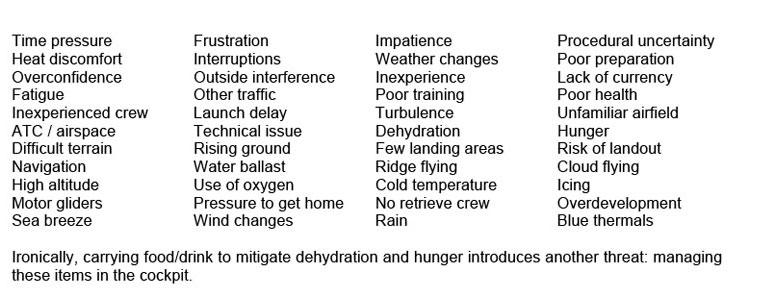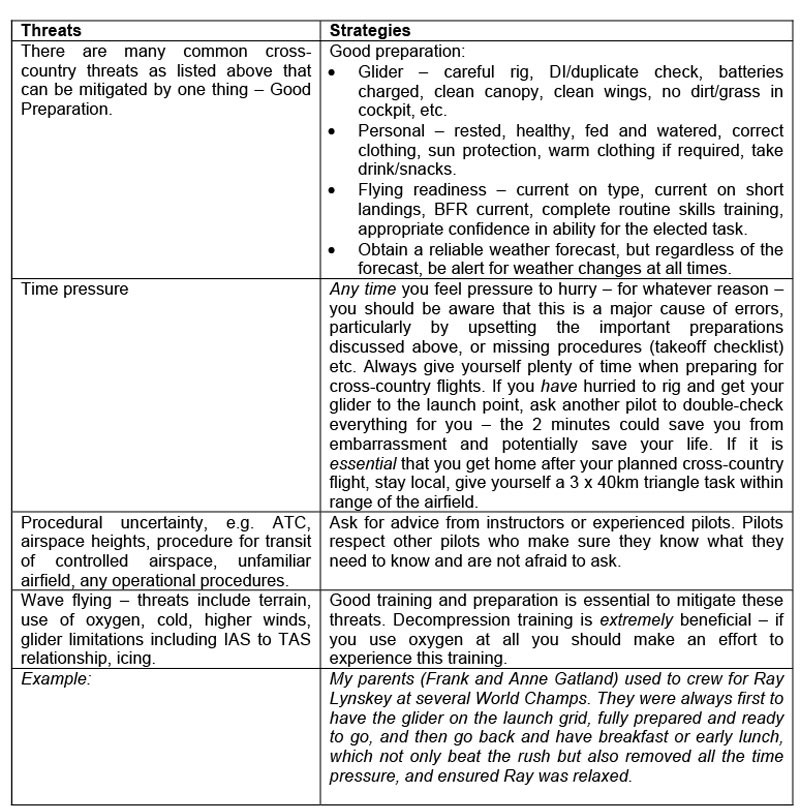In the last issue, I introduced Threat and Error Management (TEM) as a simple yet powerful technique for assessing threats affecting any and every glider flight. Recognising threats allows pilots to predict situations where they might make errors or forget something, which increases the possibility of accidents.

By Arthur Gatland
This three part series of articles was first published in Soaring NZ and is reproduced here with their kind permission.
As I said in the last issue, our accident rate in NZ is high and yet none of our spate of accidents has been the result of structural or mechanical defects – all have resulted from pilots unnecessarily putting themselves in a situation that for various reasons have resulted in a crash. Ridges, rocks and trees do not suddenly leap out and hit gliders – yet we manage to collide with them on a regular basis.
This series of articles applies to every glider pilot in New Zealand, regardless of experience.
In this article I will continue the theme of TEM as it applies to cross-country flying, an area in which we suffer a disproportionate number of accidents, many involving injury or death. Remember that to assess what constitutes a threat, we use the concept of a Pristine Flight and look for anything that introduces a variation to this theoretical flight. Let’s look at a Pristine Flight in the cross-country context.
PRISTINE FLIGHT (CROSS-COUNTRY)
This is a ‘straightforward’ cross-country soaring flight where everything goes exactly to plan. You are a current, relatively experienced cross-country pilot who has completed a number of good flights, and also have completed several successful outlandings. You arrive at the airfield and your private or club glider is available. The battery is fully charged, and other pilots are readily available to help you rig the glider and complete the duplicate check. You are prepared with drink, food, hat, sunglasses, maps etc, and you have a retrieve crew available if required. At the launch point, helpers are readily available to help you line up and a towplane is waiting. You are current on type and have flown cross-country recently. On your last flight you practised a short landing. There is light wind and it looks like a great soaring day. The weather is pleasant, not too hot. You aerotow to 2000 feet and easily find good lift. You have set yourself a relatively short task for the great conditions and your route will not go through any controlled airspace. There are many wide flat paddocks available en-route and with very light winds you have a choice of landing directions if required. During your three-hour thermal flight there is good lift everywhere and you never get so low that an outlanding is a real possibility. On return you decide not to do a ‘final glide’ and rejoin the circuit area at 1,500ft, followed by an uneventful circuit and landing. This is a Pristine Cross-country Flight – good fun with no real challenges for an experienced pilot and there are no real interruptions to your simple plan.

THREATS
Now let’s talk about likely threats or variations to your planned flight with a hypothetical example. You are running late and rushing because you are concerned that the best thermals may die out within a few hours. You need to rig your glider, but no-one is around to help, so frustratingly you have to muster a few helpers. During your daily inspection and rigging check, another pilot interrupts to ask you where you are planning to go. You had forgotten to check your battery charge level, but you think it will be okay for a three hour flight. Because you are short of time, you must hurry to get ready and you are annoyed there is a queue for takeoff. While strapping in, the duty instructor asks if you have a retrieve crew organised and criticises you when you admit you haven’t. You are annoyed that he has questioned you in front of other people as you don’t like criticism from anybody. You also realise you have left your cellphone in the car, but don’t ask someone to get it because you will look even more foolish. You forget to do your pre-takeoff checks as a result of this incident. The flight proceeds satisfactorily for the first hour, but then a moderate wind develops. You hadn’t checked the weather forecast so this is unexpected). There is some over-development with a few light rain showers, resulting in some water on your wings. You decide to try to head back towards home base, cursing your glider’s deteriorated performance and annoyed that your late departure has spoiled the day a bit. You think you might have to land out so try calling home base by radio to organise a retrieve crew, but your battery is low and you have trouble contacting anyone. Distracted by this, you suddenly realise you are at 1,000ft and haven’t even started looking at possible paddocks. However, the sun is shining on the ground a few kilometres ahead and you are sure that if you can just sneak over a ridge ahead, you should find lift. You take a chance and luckily it works out and you find weak but consistent lift and climb away. After a slow climb you make it back to home base, where you do your usual landing, halfway down the strip so you can stop by the trailer.
This hypothetical example illustrates a number of Threats, some external and some self-inflicted – and there are potentially many more. All of these variations to the Pristine Flight (threats) will increase the likelihood of you making a small slip, or an error in judgement, or forgetting something – regardless of your experience. Let’s review what these Threats might include
Cross-country flying by its very nature has a significant number of threats, including continual possibility of landout, weather changes, unpredictable lift, different terrain with changes in height above sea level, often areas of partly unlandable country, or flat but very small paddocks, use of unfamiliar hills to find ridge lift, navigation challenges, and so on. As flights are often of longer duration, dehydration and hunger are always present to some extent, and have an insidious effect on your decision-making. Wave flights introduce a specialised range of threats that require careful management. It is the presence of these threats that form part of the challenge and satisfaction of cross-country flying. However, you must not underestimate the risks that these challenges present.
MANAGING THREATS
All these threats increase your likelihood of making an error. In this context we are not talking about errors in speed-flying, like not picking the strongest thermal, or incorrect speed-to-fly technique. We are discussing errors that result in reduced safety margins, or ultimately could contribute to an incident or accident. Most pilots can very easily recognise all threats if they think about it, but a superior pilot will implement a strategy to prevent an error resulting from any of these threats. In Part One of these TEM discussions, I discussed threats occurring on local flights. Cross-country flights have all of these, plus the additional considerations discussed above. Some examples of how to manage the threats might include the following.

SOME SPECIFIC THREATS and ERRORS
There are two particular threats that I will concentrate on briefly, since New Zealand glider pilots have suffered more than their fair share of injuries and death in these situations.
1. Ridge Soaring; particularly in high country. A number of very experienced cross-country pilots have crashed while ridge soaring. Why? By definition, if you are ridge soaring there will be wind, and ridges are never totally symmetrical, which means there will be areas of stronger lift, turbulence, and sink. And hills do not move – we effectively fly into them by getting too close and/or failing to allow for wind effects. Let’s dig a bit deeper into this area of gliding.
2. Outlandings: Fact - All cross-country pilots are quite capable of landing their glider in a paddock. Fact - As a generalisation, there are sufficient landing spots anywhere we fly, although in some areas extra height and gliding distance might need to be maintained to reach them. Fact - In the 11 years prior to writing this we have had 33 major outlanding accidents with 4 fatalities and 1 serious injury. Many of these were unnecessary and were caused by pilots leaving their decision to land too late, or failing to select landing spots until too late, or pushing on hoping things would work out. Contributing factors may have been dehydration causing poor decision-making. Let’s discuss some of threats around outlandings.

INEXPERIENCE and RESPONSIBILITY
Once again, instructors and experienced cross-country pilots must help us lift our game. They should be aware that inexperienced cross-country pilots may not recognise all threats existing on any particular day. Even if a pilot is fully trained and cleared to fly cross-country without supervision, he/she can still learn from discussions with more experienced pilots. A short helpful chat to ensure they are fully prepared, and have a plan, and are mentally prepared to land out if necessary, may save their life.
As I said previously, the main ways that new pilots can gain experience and knowledge is by instructors or experienced pilots passing on these thoughts, OR learning by making mistakes! Which method is better?

CONSEQUENCES OF ERRORS
In Part One, I said that an important part of Threat and Error Management (TEM) is to understand the consequences of possible errors, and to make doubly sure the most consequential errors do not occur. Forgetting your map or not having the correct map loaded on a local flight may not be important at all, but doing the same on a cross-country flight could lead to navigation uncertainty, infringing controlled airspace etc. Stalling while pulling up into a thermal might be slightly annoying, but stalling on base turn or while trying to thermal from very low altitude will be the last mistake you ever make.
When flying cross-country, the most common safety-related errors – that of late paddock selection and/or pushing on below a safe height to join circuit to land in a paddock, and speed maintenance when ridge flying – have consistently proven to have serious implications including major damage, injury or death. Yet collectively we persist in committing these errors. To be blunt – why are we that dumb? I don’t know ... but I suspect it’s gross over-confidence, or ignorance, or denial – “It’ll never happen to me.”
All I can say is that if this applies to you, then YOU need to wake up and realise how illogical your attitude is. Just ask your wife/husband what they think about your attitude to survival.
A number of years ago, a top overseas competition pilot who was well-known for pushing on at low altitude, was heard to say, “I’m a lucky pilot, I’ve damaged 13 gliders and never been hurt.” That was not too long before his fatal accident.
SUMMARY
Every flight involves some threats, and all pilots must ensure they recognise these and have a strategy to manage the threats and prevent errors, and/or have a process to catch errors or slips that may have occurred. Remember we ALL make some mistakes on every flight – the important thing is to ensure they are not critical ones, or that they are captured before they lead to an undesirable position.
What are Threats?
Any variation to our straightforward Pristine Flight is a Threat. Every Threat increases the likelihood of an Error being committed Every Threat requires a positive strategy to manage it and prevent errors
Useful Strategies: A reminder that the following are just a few examples of TEM strategies that should become automatic to be a skilled and safe pilot.
Tem Strategies
Use SOPs / Procedures diligently
Don’t succumb to time pressure
Always fly the glider first
When fatigued be more careful and conscientious
After interruptions, say “Where was I?”
Always carry out a Situation Awareness review after a period of high workload
Set limits and stick to them – particularly with respect to landout decision making
Don’t “see what you expect to see” – look for errors
Listen to “that little voice” that questions what you are doing
Take advice from other pilots, especially experienced glider pilots
TO EVERY GLIDER PILOT
Acknowledging your vulnerability to mistakes is actually a sign of strength. In flying, you never stop learning. Every flight, whether you have 50 hours, 500 hours, or 15,000 hours, presents us with the same threats that must be recognised and managed. On every single flight you need to ask:
What are my threats today?
How will I manage and mitigate these?
In the next article I will continue the theme of Threat and Error Management into competition and other specialist flying – which is an area that has resulted in a large number of serious accidents.































